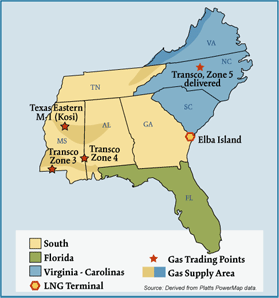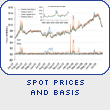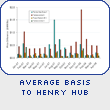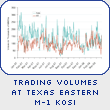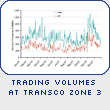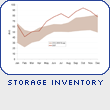| Market Description |  Back to Top Back to Top |
-
Industrial process requirements and power consumption are the fundamental drivers of the Southeast gas market. Florida is the biggest market for gas and accounts for about 30 percent of overall regional demand; the power sector comprises more than 80 percent of Florida’s total demand. Overall storage capacity is the lowest of any region in the U.S.; regional storage facilities are concentrated in Mississippi. The lack of market area storage means that pipeline companies must issue notices warning customers to seek to closely match their scheduled gas volumes with actual gas usage at times and this can result in higher basis. LNG and pipeline-related infrastructure improvements, however, have augmented regional supply diversification. Principal gas supply sources include: East and South Texas, shallow and deepwater offshore locations, coalbed methane resources in the Black Warrior Basin, as well as various onshore locations, plus imports from the Lake Charles and Elba Island LNG terminals.
| Geography |  Back to Top Back to Top |
-
States covered: Alabama, Florida, Georgia, Mississippi, North Carolina, South Carolina, Tennessee, and Virginia.
| Major Trading Hubs |  Back to Top Back to Top |
-
Florida Gas Zone 3, Texas Eastern M1, Transco Zone3, Transco Zone 4, and Transco Zone 5.
| Storage |  Back to Top Back to Top |
-
State Demand: Mississippi contains 88 percent of total Southeast capacity.
Aquifer Capacity: 0%
Depleted Field Capacity: 66%
Salt Cavern: 35%
Total Capacity: Southeast has 2 percent of total US storage.
Major Storage Pipelines and Capacity
Southern Natural Gas: 60 Bcf
Petal Gas Storage Company: 10.75 Bcf
| Demand |  Back to Top Back to Top |
-
2005
- Residential: 16%
- Commercial: 13%
- Industrial: 28%
Sector:
Southeast Total: 2.7 Tcf which makes up 12 percent of total U.S. daily demand.
Consumer Total: 8.02 million which is approximately 12 percent of total consumers in the U.S.
Key Consuming States: Georgia, North Carolina, Tennessee and Virginia make up 67 percent of the total number of consumers in the Southeast and about 8 percent of the total number of consumers in the U.S.
Residential Consumers: 91%
Average Daily Deliveries through Transcontinental Station 60:
2005:1.7 Bcfd
2006: 1.7 Bcfd
| Production |  Back to Top Back to Top |
-
States: Alabama and Virginia make up 90 percent of total Southeast production which only contributes 2 percent to total U.S. production.
Total: Total Southeast production makes up a little over 2 percent of total U.S. production.
| Pipeline Flows |  Back to Top Back to Top |
-
Average Daily Deliveries into Florida
2005: 2.1 Bcfd
2006: 2.4 Bcfd
Major Pipelines: Florida Gas Transmission, Gulfstream Natural Gas System, Southern Natural Gas Company, Texas Eastern Transmission and Transcontinental Gas Pipeline.
Average Daily Deliveries on Southern Natural Gas - Segment South of Franklinton
2005: 0.8 Bcfd
2006: 1.0 Bcfd
Average Daily Deliveries through Texas Eastern M1 @ the Kosciusko
2005: 0.9 Bcfd
2006: 0.9 Bcfd
Average Daily Deliveries through Transcontinental Station 65
2005: 0.7 Bcfd
2006: 1.7 Bcfd
| Imports and Exports |  Back to Top Back to Top |
-
Average Daily Sendout at the Elba Island LNG terminal
2005: 0.3 Bcfd
2006: 0.4 Bcfd
Major Importers: BG LNG and Marathon Oil are the principal importers of LNG at Elba Island. Re-gasified LNG is currently transported into the Southeast via the Southern Natural Gas pipeline.




